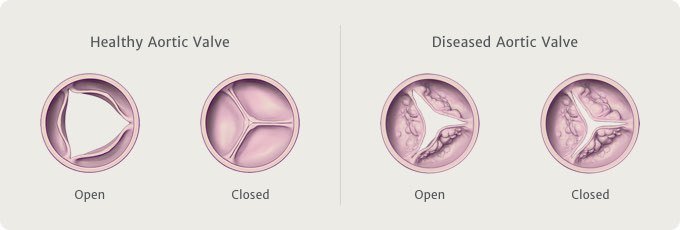Aortic Stenosis and TAVR
TAVR (transcatheter aortic valve replacement) is a procedure for people who suffer from severe symptomatic aortic stenosis (narrowing).
What is aortic stenosis?
Aortic stenosis is a common condition caused by the build-up of calcium on the aortic valve’s leaflets (flaps of tissue that open and close to regulate the one-way flow of blood through the aortic valve). This build-up impairs the valve’s ability to fully open and close. As a result, the narrowed valve allows less oxygen-rich blood to flow from the lungs to the brain and rest of the body. If this happens, you may have symptoms like:
- Severe shortness of breath with activity
- Chest pain
- Fatigue
- Lightheadedness
- Swelling in both legs
- Fluid overload (also known as heart failure), which may result in a hospital stay

Severe aortic stenosis will continue to progress, meaning the valve will continue to narrow. Without treatment, it can lead to a weakened heart and eventually death.
How do I know if I need aortic valve replacement?
If you have symptoms that may be related to severe aortic stenosis, or have been diagnosed with this condition, you will be referred to a specialist for further evaluation. The Valve Clinic will help determine if valve replacement is needed and what is the best way to replace the valve, either through traditional open-heart surgery or TAVR.
What is TAVR?
With TAVR, a new heart valve is delivered to the heart through a catheter. The catheter is inserted in the body through the groin. If this access site does not work for you, we can deliver the catheter through an incision by the collarbone, known as alternative access through the subclavian or axillary arteries.
The new heart valve is made of a strong, metal stent frame with leaflets (flaps of tissue) sewn into the inside. During the procedure, your current, faulty heart valve will be opened and pushed against the heart wall. The new valve will take its place by expanding its strong stent frame into the old calcified tissue. The new leaflets will start to work instantly, allowing blood flow out of the heart and into your body to supply the brain, organs and muscles with oxygen. Once TAVR is complete, your symptoms should improve and may even go away.
Who is a TAVR candidate?
People who are at low, moderate or higher risk for complications during open heart surgery may be candidates for TAVR. Candidates will undergo a full evaluation, which includes imaging studies (CT scan, lung function test and angiogram) and consultations with Valve Clinic team members. Once completed, we will make our best recommendations based on your individual situation.
Why undergo TAVR?
In many cases TAVR is an excellent, less invasive option for valve replacement. TAVR has shown to improve symptoms many people encounter daily due to severe aortic stenosis. TAVR decreases the workload of the heart and results in reduced shortness of breath, increased ability to tolerate activity, heightened energy levels and improved fluid balance within the body. It can also reduce the frequency of hospital stays.
For those who have symptoms of severe aortic stenosis, TAVR may be necessary. Without valve replacement, the heart can weaken, and symptoms of heart failure can continue to progress leading to a poor quality of life.
However, TAVR is not always the best option for everyone. Our experienced team will provide a full evaluation and make a recommendation on the best approach for improving your quality of life.
Why choose our program?
Our Valve Clinic started performing TAVR in 2013 and since then we have grown rapidly, completing more than 1,000 procedures. Our program is well known for its great care and excellent outcomes. In fact, our TAVR program was ranked as “high performing” in 2023 by U.S. News & World Report. The Valve Clinic also achieved a 3-star (highest) publicly reported rating in 2021 via the TVT Registry for our five-state region.
We specialize in alternative access for TAVR, such as subclavian and axillary approaches that other facilities may not offer. Specializing in this approach allows us to provide more options and opportunities for those in need of TAVR to relieve symptoms related to aortic stenosis.
In addition, unlike some other facilities, most of our patients can have the procedure under conscious sedation, meaning they are awake, but sleepy, and no breathing tube or general anesthesia is needed. Doing so can improve outcomes and shorten hospital stays.
Resources
- ACCESS Study – In a national study, research led by the Valve Clinic at CentraCare Heart & Vascular Center demonstrated that alternative vascular (artery) access sites for TAVR can be used safely and successfully, giving more patients an opportunity to have this life-saving procedure.
- American Heart Association Aortic Stenosis Resources
- New Heart Valve.com
If you have questions about our program, we would be happy to assist you. Please call us at 320-293-0750 or email us.